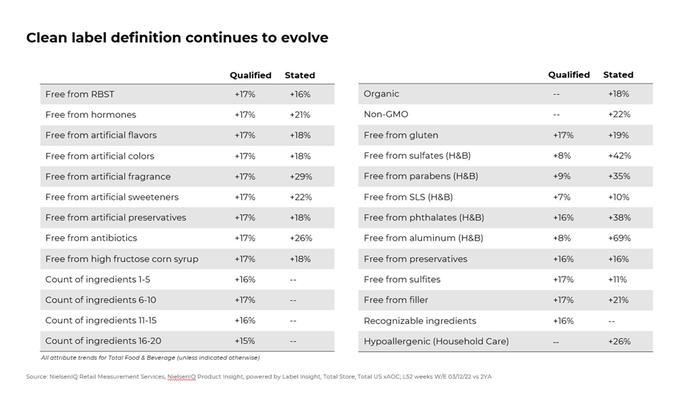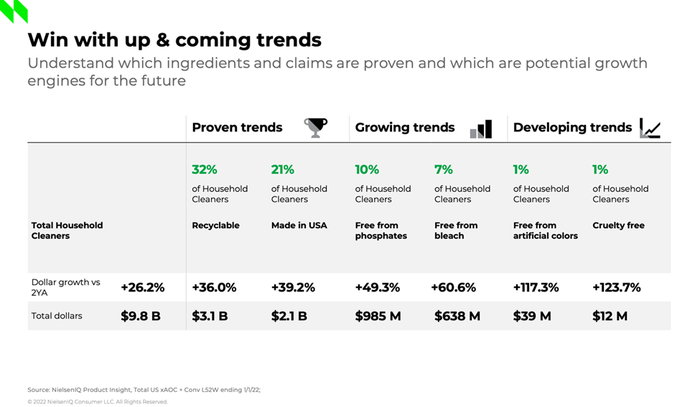For consumers, products’ clean-label and sustainability attributes are converging. Brands and retailers paying attention to both win big.
April 8, 2022

Sponsored by NielsenIQ
Over the last two years, COVID-19 has accelerated numerous wellness trends. Above all channel and category trends, one mega-trend stands to shape the future of wellness products and innovation—the convergence of personal health and planetary health in the minds of consumers.
The latest data from NielsenIQ shows consumer interest in product sustainability attributes—from planet-friendly ingredients to packaging—rising strongly alongside interest in clean-label attributes such as “free from” artificial ingredients, flavors, fragrances and antibiotics. “Many consumers have learned to expect a clean, simple and sustainable ingredient list. That is just the baseline,” says Sherry Frey, Total Wellness Leader at NielsenIQ.
“Consumers are increasingly aware that healthy-for-self can be synonymous with healthier-for-the-planet,” says Frey. From supplements to proteins to personal care, shoppers are looking for greater transparency in ingredient sourcing, labor practices and animal welfare, while also considering factors like carbon footprint and packaging waste.
Ingredients: Where Personal and Planetary Health Meet
Whether looking for quick, nutritious dinner options or for a cleaner shampoo, a consumer’s choice often centers on the ingredient list. No longer just concerned about what a product’s ingredients will do inside their bodies, consumers are more conscious about the effects of products on the planet, explains Frey.
Why? The link between ill health and environmental issues has become more apparent to consumers over the last two years. Among consumers surveyed, 61% agree environmental issues are having an adverse impact on their current and future health. Concerns about mental health, obesity, pollution and aging require brands meet consumers’ fundamental need for protection on both levels—personal and planetary.
Consumers want to take control of their health. An easy way for them to do that is to look at products’ ingredients. Ingredients written in easy-to-understand terms reassure and empower the consumer.
Beauty: The Pioneer
Trends in beauty show just how quickly clean and sustainable product attributes can take root and drive consumer expectations. Over the last decades, brands began to remove harmful ingredients. Today, more than 50% of the market is paraben-free, and mega-retailers like Target, Sephora and Ulta help consumers shop clean beauty with designated filters and clear criteria to define “clean.”
Now, sustainability attributes are poised to expand the clean beauty category. Case in point: Although “free-from” search terms appear to be on the decline, along with fragrance-free (-21%), paraben-free (-7%) and sulfate-free (-6%), the sales for beauty products with these attributes remains strong (+17%, +10%, and +8%, respectively). Searches for “plastic-free” beauty products grew an astounding 900% last year.
The takeaway? “Free-from” attributes have become widespread and expected—a necessity for brands. Whereas, over the last few years, consumers have become more aware of plastics’ negative effects on ocean health as well as personal health. Increasingly, consumers want beauty brands to address issues of product waste and overall environmental impact/footprint.

Win-Win: Plant-based Ingredients
In plant-based ingredients, consumers see a solution that addresses both environmental and personal health concerns. Clean, healthier options (hormone free, antibiotic free, non-GMO) are perceived as better for the planet. Plant-based product sales are up 48% in just two years: 49% in food and beverage, 66% in vitamins and OTC, 39% in personal care and 7% in pet care. Plant-based products are now worth an estimated $111.7 Billion in the global market.
Sustainability and health benefits of a plant-based diet are co-promoted by leading organizations, such as the World Health Organization. A recent Stanford University report points out that “plant sources can reduce body weight, blood pressure and risk of heart disease, cancer and diabetes—and it can make your environmental impact more sustainable.”
Cleaning Up Household Products
Consumers want to reduce exposure to environmental contaminants, including those in their home, more than ever. This is another category in which healthier-for-me-and-the-planet ingredients are front and center of innovation and growth. In fact, 66% of consumers say they would pay more for products with hygiene/safety/protection claims.
Over the last two years, recyclable products grew 36% (now worth $3.1 Billion in the marketplace), free from phosphates (49.3%) and free from bleach (60.6%), free from artificial colors (117.3%) and cruelty free (123.7%).

The Future of Clean Label is Sustainable
“Across all consumer segments, we’re seeing more people say, ‘I’m willing to take action on environmental issues,’” says Frey. “And we’re seeing much innovation of products that are good for the earth and healthy.”
And consumers are willing to pay a bit more to meet those needs. According to NielsenIQ research, 72% of surveyed respondents around the world say they would be willing to pay a premium for products that claim to be sustainable – where, 52% would be willing to pay a little bit more and 20% of global consumers would be willing to pay a lot more for sustainable products.
Brands and retailers must recognize shoppers’ emerging priorities. Consider this: According to NielsenIQ Label Insight, 81% of searches on Amazon are unbranded. That means consumers are prioritizing attribute, benefit and price rather than brand name. To ensure visibility and loyalty in any space—digital or brick and mortar—brands will need to feature product claims that match with both consumer clean-label and sustainability trends.
You May Also Like


